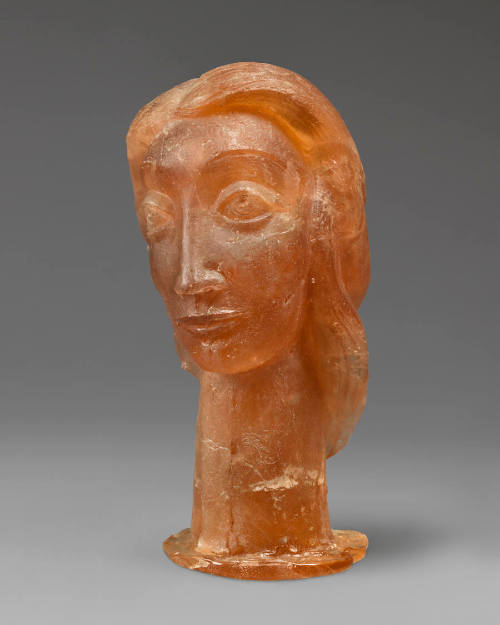- Open today, 10 am to 5 pm.
- Parking & Directions
- Free Admission

Summer Day (Self-Portrait)
- Woman
- Head
- Amber
"Out of the Mold - The Creative Possibilities of Kiln-Cast Glass," Peninsula Fine Arts Center, Newport News, Va., April 2 - June 12, 2005.
"Women of the Chrysler: a 400-Year Celebration of the Arts," Large Changing Gallery, Chrysler Museum of Art, Norfolk, Va., March 24 - July 18, 2010.
"Get Real: Figurative Sculpture by Women," Peninsula Fine Arts Center, Newport News, VA, September 20, 2019 - January 5, 2020.
American, 1905–98
Summer Day (Self-Portrait), 1967
Lost-wax (cire perdue) cast glass
Museum purchase with funds provided by Paramount Industrial Companies, Inc. and Arthur and Renée Diamonstein 94.6
Edris Eckhardt created pioneering works of art in both glass and ceramics. As a student at the Cleveland Institute of Art in the 1930s, she worked primarily with ceramics. She became involved with the Federal Art Project, working during the Great Depression to create ceramic tiles for public housing projects in the Cleveland area and figurines of popular literary figures for libraries.
Eckhardt began experimenting with glass in 1952. She began melting her own glass colors in her home and testing the compatibility of them with each other. Her most groundbreaking work combined glass with other materials, such as bronze, an extremely difficult process to master. By the end of the 1950s, she had also learned how to cast glass in lost-wax molds, with Summer Day (Self-Portrait) characteristic of her figurative glass sculptures.
Summer Day (Self-Portrait)
1967
Edris Eckhardt
American, 1905–1998
Cire perdue glass
87/8 × 41/4 × 5 in.
(22.5 × 10.8 × 12.7 cm)
Museum purchase, Paramount Industrial Companies, Inc., Contemporary Glass Fund with the Assistance of Arthur and Renée Diamonstein, 94.6
This sculpture of a woman’s head cast in amber-colored glass is a telling self-portrait by the artist Edris Eckhardt. Tilting slightly to the side with a peaceful and calm facial expression, the portrait is abstractedly rendered, with thin lines for eyebrows on the small forehead and a long, pointed nose. Her hair is parted to the side and falls down her elongated neck. Her large expressive eyes gaze upward, and her thin lips smile ever so slightly, evoking the contemplative feeling of a relaxing summer day. The seasons are among the many sources from which Eckhardt found inspiration. Summer Day (Self-Portrait), with its rough surface texture, is characteristic of her figurative glass sculptures cast in a mold using the cire perdue, or lost-wax, process.
Recognized as an innovative artist of her time, Eckhardt enjoyed a career as a sculptor that spanned the 1930s to the 1970s (fig. 46). She worked across a variety of media, including ceramics, enamels, glass, and bronze. Eckhardt specialized in sculpture at the Cleveland School of Art (now the Cleveland Institute of Art) and went on to teach ceramics at her alma mater and other universities. Her given name was Edythe Aline, but she changed it to the androgynous-sounding Edris to avoid gender stereotyping in her artistic career.1 During the Great Depression, Eckhardt was involved in the Federal Art Project, creating ceramic wall tiles, murals, and sculpture for public housing projects, and figurines of popular characters from children’s books for public libraries.2
After working primarily in ceramics in the 1930s and 1940s, Eckhardt began experimenting with glass in 1953. She made pioneering contributions in the early years of the Studio Glass movement in the United States and was among the first artists to formulate her own glass batch mixtures. Throughout the 1950s and 1960s, she worked in techniques that few artists were using at the time, including pâte de verre, cast sculpture, and flat pictorial panels in gold glass.3 Eckhardt encountered Roman, Egyptian, and Byzantine gold glass in museum collections and revived the lost technique after experimenting with it in the 1950s.4 The subject matter of her abstract and figural freestanding sculptures, bas reliefs, and laminated panels ranged from biblical and medieval themes to visions and dreams and plants and animals. She also explored and mastered an extremely difficult mixed-media technique combining bronze with glass inclusions to create abstract sculpture. While most studio glass artists of her time were focused on glassblowing, Eckhardt showed the creative potential of a variety of complicated glassmaking techniques. | msh
Notes
1. Eckhardt ascribed her new name to a genderless archangel from a biblical source, but it also may have been inspired by a female character in an 1889 romantic novel, Ardath: The Story of a Dead Self, by Marie Corelli. The artist liked the ambiguous name, as it seemingly allowed her to not be prejudged as a woman. Henry Adams, "Edris Eckhardt: An Artist’s Life," in Henry Adams et al., Edris Eckhardt: Visionary and Innovator in American Studio Ceramics and Glass (Lakewood, OH: Cleveland Artists Foundation, 2006), 17–18.
2. The Federal Art Project was a branch of the Works Progress Administration. From 1935 to 1941, Eckhardt served as head of the Cleveland District Sculpture and Ceramics Division; the artist has cited her work from this period as among her most significant achievements. Ibid., 23.
3. The process to make gold glass involved fusing an image in delicate gold leaf between laminated sheets of glass.
4. Eckhardt was stimulated to experiment with a formula after seeing ancient gold glass at the Museum of Fine Arts, Boston, and the Metropolitan Museum of Art, New York. She won a Guggenheim Fellowship in 1956 for her rediscovery of the technique, which had been lost for fifteen hundred years.
Fig. 46 Edris Eckhart, ca. late 1950s. Collection of Elaine and Joseph Kisvardai
